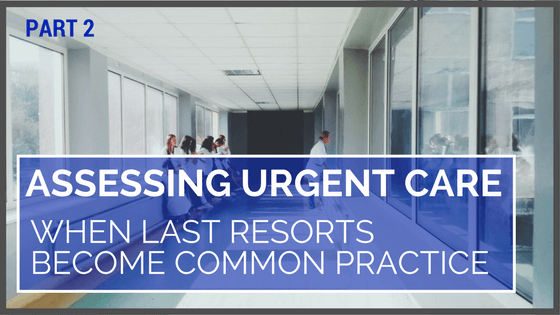(Continued from Part I)
Clearly, patients aren’t using primary care services as much as they should – but can that all be chalked up to convenience? Studies say no. According to an 2015 NPR poll, 20% of surveyed patients choose urgent or emergency care services because they were “unable to see their regular doctor when they needed medical care, mostly because the doctor didn’t have any available appointments, the office was closed, or the doctor was out of the office.” This issue comes across in other studies as well; in the BMC article referenced above, researchers found that 15.7% of patients cited the inability to get off of work in time to make primary care hours as a reason for choosing urgent care. Interestingly, the same study found that “the vast majority [of patients] suggested that they would have chosen a primary care clinic over urgent care if it were open during the weekend or evening hours.” This suggests that the problem doesn’t fall so much to an aversion to primary care as a solution, but to a real issue of access.
At this point, we have to look into the barriers economic class poses to long-term medical care. A salaried, middle-class office worker might be able to take an hour or two over her lunch break to visit her primary care physician – but could the financially strapped construction worker in the opening scenario do the same? Those working hourly jobs might not have the luxury of taking time off or possess the funds needed to cover the out-of-pocket cost, especially if they aren’t insured. Patients who seek emergency services over primary care tend to avoid seeking out medical attention until absolutely necessary: among those in the BMC study who put off seeking medical attention for two or more days, 50.1% cited not feeling enough pain and 45.9% reported not feeling sick enough as their reasons for delaying care. If we look at the situation through a financial lens, the choice to go to urgent care makes sense: it’s convenient, accessible, and solves the immediate problem quickly without compromising a patient’s ability to make a living or demanding too much of their financial resources. But this also indicates a widespread view of medical care as a last resort, rather than a regular practice, and supports the earlier-mentioned findings that those who utilize emergency services for primary needs are significantly less likely to have a primary physician.
Primary health care delivery needs to be better. Right now, the trend towards using emergency services to fill primary care needs poses a problem to both critical-care facilities and patients who don’t have the long-term support of a primary care doctor. The problem won’t be solved in a year, or even ten – but if we are to provide inclusive, quality care to all patients, it must be addressed. We need to expand primary care access to reach patients who aren’t able to make primary clinic hours or afford copayment costs, and ultimately aim to change the narrative around medical care to on that prioritizes long-term preventative care over quick fixes. Quality and long-term primary healthcare shouldn’t only be available to those who can afford it – and a healthy life shouldn’t come with a price tag attached.


